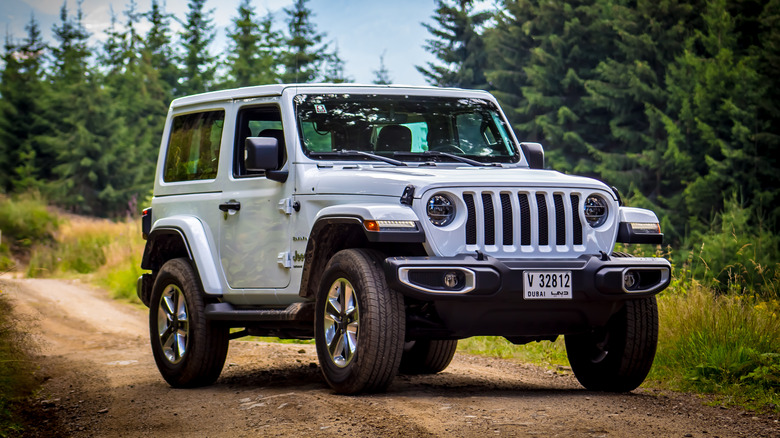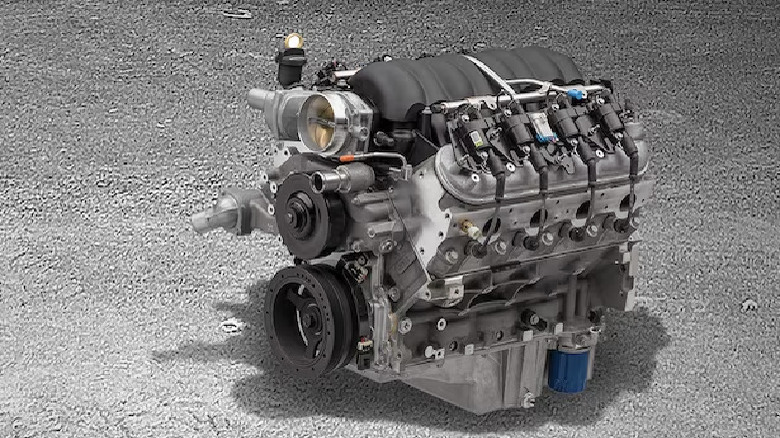The 5 Best Engines To Put In A Jeep Wrangler
Of all the vehicles on the road, one of the most recognizable is undoubtedly the legendary Jeep Wrangler. The Wrangler began its long lifespan as a close sibling to the bare-bones military Jeeps built to move troops and gear but has since evolved into a refined SUV with sectioned removable hardtops and modern conveniences like navigation systems and airbags.
Since Jeep debuted the go-anywhere, do-anything Wrangler for the 1987 model year, owners have been comfortable making extensive modifications to their rugged, boxy playthings. These changes have traditionally included engine swaps, which are still common now considering the limited factory offerings for the newest iteration of the Wrangler, the JL.
New Jeep buyers currently have only four options off the lot: a 2.0L 4-cylinder, a 3.6L gas-powered V-6, a 3.0L Eco-diesel, and a 6.4L hemi V8 that is available only in the top-end Rubicon models. Let's take a quick look at each of the stock powerplants and some of the commonly chosen options for engine swaps for mechanically inclined and deep-pocketed Jeep owners.
Most sensible option for most: the 2.0L I-4
For most drivers, the 2.0L turbocharged 4-cylinder engine will be the best choice. Jeep's smallest stock option for the JL Wrangler puts out 270 horsepower and gives the Wrangler a towing capacity of 3,500 pounds. Wranglers with the 4-cylinder motor boast a respectable 22mpg city and 24mpg highway; not bad for a vehicle with the aerodynamics of a cinderblock and a curb weight of more than two tons. For most drivers, the 2.0L I-4 is the most reasonable choice, especially with gas prices on the rise again. The 2.0L Wrangler is zippy enough around town to keep up with traffic, and the longer upper gearing makes it a capable highway rig as well.
The 2.0 is even a decent choice for off-roading, providing a smooth delivery of power through the lower gears and 295 pound-feet of torque to pull through the deepest sand and mud. With its versatile all-around performance, Jeep's smallest engine is probably the best factory option for the wide variety of situations most Wrangler drivers will find themselves in. Christian Hazel of Motortrend wrote of the 4-cylinder turbo motor, "For me, the 2.0L blends the best balance between power and drivability while imparting the perception that the vehicle is lighter and airier."
Two different V-6 options
For Jeepers looking for some more horses under the hood, the manufacturer also offers two V-6 options, including a naturally aspirated 3.6L version. Of all of Jeep's current powerplants, this one is most evocative of the bulletproof 242 and 258 cubic inch 6-bangers used in YJ Wranglers and CJ7 models and the XJ model Cherokees of yesteryear. Jeep has dubbed the 3.6L engine the Pentastar, presumably taking the name — quite unoriginally — from that of their parent company's corporate logo. Jeep's 3.6L V-6 cranks out 285 hp and 260 lb-ft of torque, enough to shake the bones of driver and passengers alike.
The 3.6L motor pairs well with Jeep's 8-speed automatic transmission, which helps get that ample torque to the road with a minimum of hunting or wasted effort. That extra displacement and power come with a cost, however, as it brings the fuel consumption of the 3.6L-equipped Wrangler down to 20mpg city and 24 highway. With its low-RPM torque curve, the Pentastar is also a fine option for off-roading, especially when mated with the 6-speed manual transmission.
Another factory option on the JL Wrangler is a beefy 3.0L EcoDiesel offering 260 horsepower and a whopping 442 ft-lb of torque. While the EcoDiesel Wrangler models will feel more truck-like than the nimbler four-cylinder and naturally aspirated six-cylinder models, they actually offer the best fuel mileage — 22 city and 29 highway. The ridiculous amount of torque makes the EcoDiesel the best option for rock crawling and mudding, and the miserly fuel consumption will help offset the premium price for the EcoDiesel engine.
Rubicon buyers get Chrysler's celebrated Hemi engine
For the 2022 model year, Jeep began offering Chrysler's popular and powerful Hemi V8 engine in the top-end Wrangler Rubicon. The Rubicon version of the Hemi puts out a staggering 470 horsepower and 470 ft-lbs of torque, and Jeep touts a 0-60 time of 4.5 seconds and a 1/4 mile time of 13 seconds. That puts the Rubicon roughly on par with the fastest production cars ever made; the Shelby Cobra and the Corvette 427. While nobody appeared to be clamoring for a Jeep that could keep up with a Cobra and a Corvette, vintage Jeep aficionados nostalgic for the old V-8 days are no doubt pleased to see the larger engines back under the hood of the Wrangler again.
But while the Hemi V-8 Rubicon's eye-popping performance numbers were enough to win it Motor Trend's 2022 award for Four Wheeler of the Year, some of the Hemi Rubicon's other specs were just as outlandish without being as impressive: for example, the $80,000-plus price tag and the 13mpg city/17mpg highway fuel consumption.
But for intrepid Jeep owners with a robust toolbox and some friends willing to get their hands dirty, there are some non-factory options available to power even the newest Wrangler models.
Chevy LS engines are commonly swapped into Wranglers
For decades, Jeep CJ and Wrangler owners have been dropping Chevy LS series engines into their trusted vehicles. LS engines can be found in any salvage yard, parts and upgrades for them are cheap and readily available, and they have a solid reputation for long life and reliable operation.
There are also a variety of third-party conversion kits for sale and plenty of YouTube how-to LS/JL swap videos. It's not just Jeep owners who favor LS swaps. Holley's 2022 LS Swap Fest in Kentucky even featured a 1969 Corvair, a 1988 Pontiac Fiero, and a 1991 Toyota MR2. LS swaps will require vehicles to be adapted to account for motor mounting and transmission mating, wiring, gauges, fuel delivery, and temperature regulation. But once all the initial conversion work is done, most LS swappers not only enjoy miles and miles of stress-free operation, but a robust network of aftermarket performance parts and technical support.
The 4BT Cummins Diesel is another reliable choice for Wrangler owners
Cummins has been making diesel engines for more than a century, so it makes sense that Jeep owners would turn to the venerated brand to power their trusted rigs. Cummins' 3.9L 4BT motor has similar dimensions as Chevy's LS engines and requires about the same amount of adaptation and bits of extra fiddling to complete the swap. Just as with the LS motors, there are plenty of online shops and YouTube tutorials dedicated to this complicated but eminently doable operation. The advantages of the 4BT are similar to those of Jeep's own 3.0L diesel offering: a mule-team low-end torque pull and miserly fuel consumption are tops on that list.
The Cummins engine also offers a long track record of reliability and ease of maintenance. The engines are exceptionally heavy, however, and many Jeeps will require suspension modifications to support the weight of a Cummins engine. But regardless of whether you choose to go with one of the factory offerings or one of the many potential aftermarket swaps, a Jeep Wrangler will bring years of open-air fun while turning heads your way.





